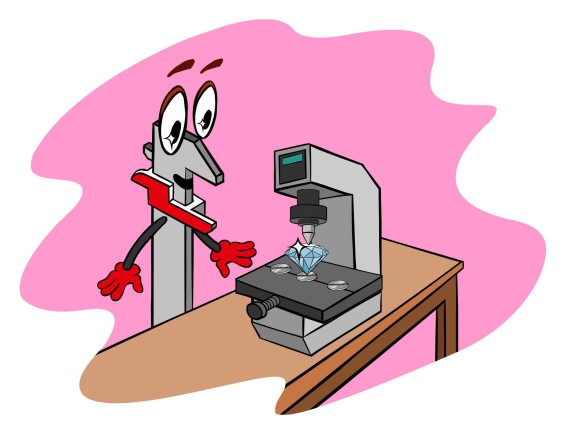Surface hardness test – Mr. Caliper explains how it works
Mr. Caliper, what exactly is a surface hardness test?
This test determines the hardness, usually with low test loads, on the surface of the component.
Why is it important?
The surface hardness test is performed usually with low test loads (e.g. 300g) and as close as possible on the surface of the component. If the surface is is too hard, the product can either be carburised or the total hardness is too high. If the surface hardness exceeds, then the product becomes prone to brittle fracture.
If the surface area is too soft and consequently less carbon is present (decarburisation), the thread, for example, cannot bear the stress when the load is applied. This can also lead to failure of the component.
Which surface hardness tests can be performed in the accredited laboratory of Würth Industri Norge?
The surface hardness can be checked with various hardness testing methods. These range from Vickers, different Rockwell methods to Brinell, which is a rather rare test method for surface hardness. These methods depend on the to be tested product, the requirement of the norms as well as requirement of the customers. Thus, the method HV0.3 is used for screws. In case of dowel pins, HRC is mostly used for testing the surface hardness.
Test sequence
Mr. Caliper is ready for testing the surface hardness. Take a look inside our laboratory and learn about the individual steps in detail!

The test method as well as the tolerances required should be defined in the suitability test. The product should have a sufficiently large test surface, which is later prepared for the surface hardness test.

For the surface hardness test, you need a flat and scratch-free test surface. Unlike the core hardness test, the sample is not embedded. This complicates the sample preparation. Since most of the products have a coating, it has to be removed beforehand. For this purpose, the screw head is carefully grinded with a fine sandpaper. It is important to ensure that the coating is removed completely on the test spot and, at the same time, not too much of the base material is removed from the screw. It is ideal, if only the coating is removed. Afterwards, the sample is polished with a diamond suspension. You can recognise a good sample preparation by the fact that the residues of the coating are visible next to the test surface.

The test device is reviewed, as it is during the core hardness test. A corresponding hardness test block is measured and values are documented. Then, it is decided, whether the machine can be used. The laboratory of Würth Industrie Service carries out these checks every day for each test method implemented and the corresponding hardness range.

The test is performed mostly in HV0.3. The diamond pyramid is pressed into the surface of the sample with a force of 300g. Thus, the hardness indentation is relatively small. This has the advantage that a possible carburisation is not penetrated. It should also be ensured that the test surface lies flat for the indenter. During this test method, even a minor unevenness has a major impact on the test result. The hardness indentation is distorted and does not give the actual result. The hardness indentations are spread over the test spot and subsequently analysed.

For evaluating the result, a report similar to core hardness is also created here. It should be noted that only an upper tolerance of 390 and 435HV0.3 for the property classes 10.9 and 12.9 is defined for the surface hardness test as per DIN EN ISO 898-1. In case the reading appears too low, a microstructure analysis should be conducted to display and evaluate a possible decarburisation. If the checked surface hardness is too high, there is the risk of carburisation, which can lead to brittle fracture.
Complete overview of the tests
Go to the complete overview and select the next test to learn about further details from Mr. Caliper!
Go to complete overview
Go to the next test
Go to the next test of our test laboratory with Mr. Caliper and find out about microstructure analysis!
Go to microstructure analysis
The Würth Industrie Service GmbH & Co. KG collects and processes the personal data provided in the form in order to process the requested request for you. Please note the mandatory fields in the forms. The legal basis for this processing, the absolutely necessary data, is Art. 6 para. 1 lit. b DSGVO, implementation of a pre-contractual measure. The processing of data voluntarily provided by you is carried out on the basis of Art. 6 para. 1 lit. f DSGVO. Thereafter, processing is permissible which is necessary to safeguard our legitimate interests. Our legitimate interest is to have contact with you, our customers, to improve our consulting quality and to be able to contact you more easily in case of possible queries. The data collected will only be stored by us for as long as is necessary to process your enquiry and to contact you. They are then deleted.
Supplementary data protection information, in particular regarding your rights to information, correction, deletion, restriction of processing, objection and complaint, can be found in our data protection declaration.
